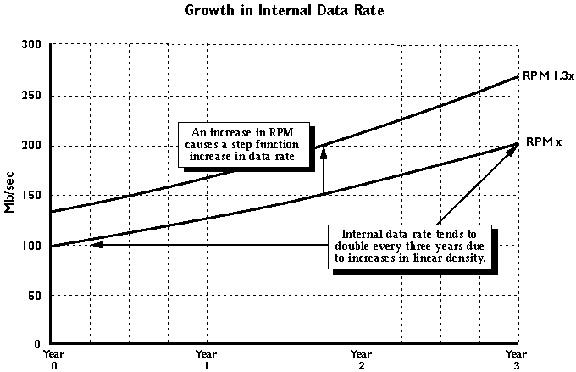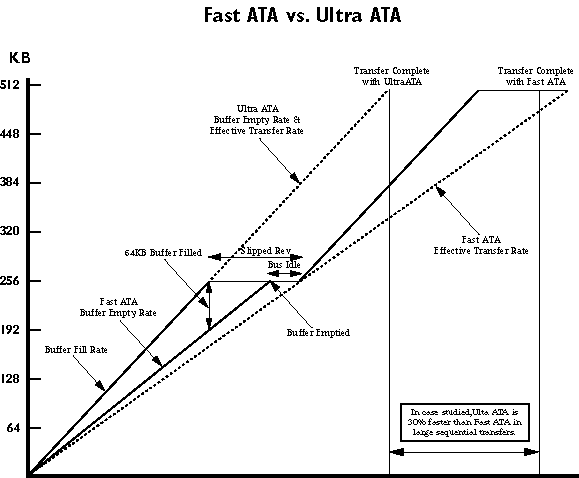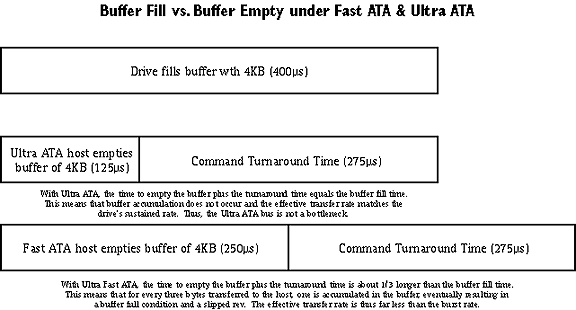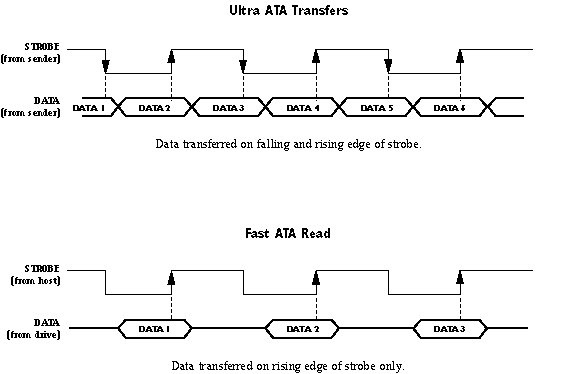ULTRA ATA
A Quantum White Paper
Performance-enhanced interface -- with transfer rate-doubling
protocol -- dramatically improves throughput, heightens integrity and
saves costs without major system modifications.
Introduction
In the computer world, as elsewhere, the word "system" implies an
ordered complex of components, all working in balance. Ideally,
advances in microprocessor performance, more capable operating
systems (OS), application software and higher capacity, higher
performance data storage all move in lockstep, each leveraging the
other. But to take advantage of these enhancements, the connection
between host and storage must be similarly improved. Specifically,
the internal data rates of hard disk drives have been getting so fast
that the host/drive connection is becoming a performance bottleneck
ó and an interface improvement is needed to regain
balance.
The vast majority of desktop systems shipping today -- upwards of
90 percent -- rely on the ATA/IDE hard disk drive interface for
moving data between the disk drive buffer and system memory. This
dominance is not likely to change in the near future. The current
interface, called Fast ATA, supports a burst data transfer rate of
16.7 megabytes per second (MB/s). To avoid bottlenecks during
sequential transfers -- such as system boot-up, the loading of
increasingly large programs, and especially desktop video
applications -- it is now necessary to greatly increase this transfer
rate to keep up with internal data rate improvements.
This paper explains how, with the development of the new transfer
protocol of Ultra ATA, Quantum has doubled the burst transfer rate to
33 MB/s, providing higher levels of disk throughput yet also
enhancing data integrity. It also examines the cost benefit resulting
from a drive designer's ability to avoid adding extra buffer memory
to compensate for a slower rate.
Already, the industry is lining up behind Ultra ATA. Chipset
vendors, including market-leader Intel Corporation, have announced
support of the new protocol, as have all leading hard drive
manufacturers, including IBM, Maxtor, Seagate Technology and Western
Digital. The first drives with Ultra ATA -- the Quantum Fireball ST
series of 3.5-inch hard drives -- debuted in October 1996, and the
first desktop systems incorporating Ultra ATA technology will likely
ship in early 1997. With full backwards compatibility with Fast ATA,
Ultra ATA is on track to become the new industry standard ATA/IDE
protocol. And with performance that now rivals that of Ultra SCSI,
ATA's dominant position on the desktop may grow even stronger.
Problem: The Need For Speed
Continually faster microprocessors, ballooning file sizes,
multitasking operating systems, higher bandwidth buses, higher
performance hard drives -- the need for speed saturates today's
desktop systems. As it turns out, a hard drive's speed scales
naturally with the drive's capacity, and the disk drive industry
traditionally doubles disk storage capacity every eighteen months.
This is accomplished by making the tracks on the disk closer together
(track density) and by making the data written on each track more
dense (linear density), usually in roughly equal proportion. As a
result, linear density doubles about every three years. This in turn
doubles the drive's internal data rate because more data is available
to come streaming off the disk during each rotation.
In addition, because a drive's internal data rate depends on both
linear density and rotational speed, the tendency to increase
rotational speed over time accelerates this doubling of the internal
data rate (see Figure 1).

Figure 1
A hard drive's internal disk data rates continue to
increase with expansions in disk capacity and higher rotational
speeds
At the same time, file sizes are increasing dramatically as the
result of larger programs, emerging multimedia applications and so
on. On a defragmented disk, these files are typically written
sequentially -- track after contiguous track.
The transfer of large files can be particularly affected by the
transfer rate. This is because the drive, with its fast internal data
rate, may be filling its buffer faster during sequential reads than
the host can empty it (see Figure 2). Let's look at why.

Figure 2
Fast internal transfer rates mean that a drive's
buffer can fill faster than the host--using Fast ATA--can empty it
and turn around commands, resulting in "slipped revs"
Inefficient bus utilization
Today's fastest high-density drives can sustain sequential transfers into the buffer at just over 10 MB/s. One would think that, with a burst transfer rate of 16.7 MB/s, Fast ATA could easily keep the buffer from becoming full. The reason it can't has to do with the turnaround time the host computer (PC) takes between the commands it issues to the drive.
This command turnaround time -- during which the bus remains idle
-- is essentially overhead and constitutes a very significant portion
of the overall time available on the bus.
Because the effective data transfer rate of the bus equals
the burst transfer rate minus the command turnaround time, it
is this overhead that can make the effective transfer rate of Fast
ATA insufficient.
What it boils down to is that host PCs are not making efficient
enough use of the ATA bus. Command turnaround overhead is propagated
by the number of commands a host makes to a drive, which in turn is
dependent on the size of the requests. These requests are typically 4
KB in size, equivalent to the page size supported by a
virtual memory operating system. Let's do the math.
Running the numbers
It takes approximately 400 microseconds(ms) for a drive to read 4
KB of data into its buffer at a sustained sequential data rate of
10.2 MB/s. Given Fast ATA's burst transfer rate of 16.7 MB/s, the
host can empty the buffer of 4 KB in about 250ms. This leaves 150ms
for overhead between commands -- to keep the filling and the emptying
of the buffer in balance. Unfortunately, the fastest desktop PCs have
command turnaround times in the 275ms range. Thus you are looking at
525ms to empty 4 KB from the buffer, which reduces the effective
transfer rate of Fast ATA to approximately 7.8 MB/s (4096 bytes
divided by 525ms). That's quite a bit lower than its 16.7 MB/s burst
transfer rate.
7.8 MB/s is also only 75 percent of the drive's 10.2 MB/s sequential data rate -- meaning that for every three bytes sent to the host, one byte accumulates in the buffer. Thus, each time three buffers worth of data is sent to the host, one buffers worth of data is accumulated, and the drive must "slip a rev"(allow the desired sector to rotate once again past the head) to allow the host to drain the buffer. Given that a buffer segment is typically 64 KB, a rev would be slipped roughly every 256 KB -- a distinct underutilization of a drive's capabilities.

Figure 3
By doubling the rate at which the buffer is emptied, Ultra ATA compensates for command turnaround overhead and avoids "slipped revs."
Solution options
There are several ways to address the situation so that ATA is no
longer a bottleneck. The traditional method is to improve the burst
transfer rate at the system level by implementing Ultra ATA, for
example, so that the time spent actually transferring the data from
the buffer is reduced. For example, with Ultra ATA's 33 MB/s burst
transfer rate, a 4 KB data block transfers in just 125ms. This leaves
275ms for overhead. 125ms plus 275ms yields 400ms, matching the
buffer fill rate discussed above. As a result, the buffer does not
accumulate data and no revs are slipped.
There are two other options as well, both of which lie outside the
control of a disk drive vendor. The more difficult way would involve
reducing command turnaround times. Increases in processor speed can
contribute here, but the present improvement rate is insufficient so
decisive improvements would require re-architecting the interrupt
priority structure. An easier approach might be to increase the size
of host-to-drive requests. Doubling the request size from 4 KB to 8
KB, for example, would cut the fixed command turnaround overhead in
half. Should it prove difficult or impractical to extend ATA beyond
33 MB/s through further protocol changes or hardware modification
(e.g. reduced cable length, etc.), increasing the request size may
prove to be the most propitious approach.
Buffering the consequences
